Hao Liang
DataFlow: An LLM-Driven Framework for Unified Data Preparation and Workflow Automation in the Era of Data-Centric AI
Dec 18, 2025Abstract:The rapidly growing demand for high-quality data in Large Language Models (LLMs) has intensified the need for scalable, reliable, and semantically rich data preparation pipelines. However, current practices remain dominated by ad-hoc scripts and loosely specified workflows, which lack principled abstractions, hinder reproducibility, and offer limited support for model-in-the-loop data generation. To address these challenges, we present DataFlow, a unified and extensible LLM-driven data preparation framework. DataFlow is designed with system-level abstractions that enable modular, reusable, and composable data transformations, and provides a PyTorch-style pipeline construction API for building debuggable and optimizable dataflows. The framework consists of nearly 200 reusable operators and six domain-general pipelines spanning text, mathematical reasoning, code, Text-to-SQL, agentic RAG, and large-scale knowledge extraction. To further improve usability, we introduce DataFlow-Agent, which automatically translates natural-language specifications into executable pipelines via operator synthesis, pipeline planning, and iterative verification. Across six representative use cases, DataFlow consistently improves downstream LLM performance. Our math, code, and text pipelines outperform curated human datasets and specialized synthetic baselines, achieving up to +3\% execution accuracy in Text-to-SQL over SynSQL, +7\% average improvements on code benchmarks, and 1--3 point gains on MATH, GSM8K, and AIME. Moreover, a unified 10K-sample dataset produced by DataFlow enables base models to surpass counterparts trained on 1M Infinity-Instruct data. These results demonstrate that DataFlow provides a practical and high-performance substrate for reliable, reproducible, and scalable LLM data preparation, and establishes a system-level foundation for future data-centric AI development.
Scone: Bridging Composition and Distinction in Subject-Driven Image Generation via Unified Understanding-Generation Modeling
Dec 14, 2025Abstract:Subject-driven image generation has advanced from single- to multi-subject composition, while neglecting distinction, the ability to identify and generate the correct subject when inputs contain multiple candidates. This limitation restricts effectiveness in complex, realistic visual settings. We propose Scone, a unified understanding-generation method that integrates composition and distinction. Scone enables the understanding expert to act as a semantic bridge, conveying semantic information and guiding the generation expert to preserve subject identity while minimizing interference. A two-stage training scheme first learns composition, then enhances distinction through semantic alignment and attention-based masking. We also introduce SconeEval, a benchmark for evaluating both composition and distinction across diverse scenarios. Experiments demonstrate that Scone outperforms existing open-source models in composition and distinction tasks on two benchmarks. Our model, benchmark, and training data are available at: https://github.com/Ryann-Ran/Scone.
BRACE: A Benchmark for Robust Audio Caption Quality Evaluation
Dec 11, 2025Abstract:Automatic audio captioning is essential for audio understanding, enabling applications such as accessibility and content indexing. However, evaluating the quality of audio captions remains a major challenge, especially in reference-free settings where high-quality ground-truth captions are unavailable. While CLAPScore is currently the most widely used reference-free Audio Caption Evaluation Metric(ACEM), its robustness under diverse conditions has not been systematically validated. To address this gap, we introduce BRACE, a new benchmark designed to evaluate audio caption alignment quality in a reference-free setting. BRACE is primarily designed for assessing ACEMs, and can also be extended to measure the modality alignment abilities of Large Audio Language Model(LALM). BRACE consists of two sub-benchmarks: BRACE-Main for fine-grained caption comparison and BRACE-Hallucination for detecting subtle hallucinated content. We construct these datasets through high-quality filtering, LLM-based corruption, and human annotation. Given the widespread adoption of CLAPScore as a reference-free ACEM and the increasing application of LALMs in audio-language tasks, we evaluate both approaches using the BRACE benchmark, testing CLAPScore across various CLAP model variants and assessing multiple LALMs. Notably, even the best-performing CLAP-based ACEM achieves only a 70.01 F1-score on the BRACE-Main benchmark, while the best LALM reaches just 63.19. By revealing the limitations of CLAP models and LALMs, our BRACE benchmark offers valuable insights into the direction of future research.
VABench: A Comprehensive Benchmark for Audio-Video Generation
Dec 10, 2025Abstract:Recent advances in video generation have been remarkable, enabling models to produce visually compelling videos with synchronized audio. While existing video generation benchmarks provide comprehensive metrics for visual quality, they lack convincing evaluations for audio-video generation, especially for models aiming to generate synchronized audio-video outputs. To address this gap, we introduce VABench, a comprehensive and multi-dimensional benchmark framework designed to systematically evaluate the capabilities of synchronous audio-video generation. VABench encompasses three primary task types: text-to-audio-video (T2AV), image-to-audio-video (I2AV), and stereo audio-video generation. It further establishes two major evaluation modules covering 15 dimensions. These dimensions specifically assess pairwise similarities (text-video, text-audio, video-audio), audio-video synchronization, lip-speech consistency, and carefully curated audio and video question-answering (QA) pairs, among others. Furthermore, VABench covers seven major content categories: animals, human sounds, music, environmental sounds, synchronous physical sounds, complex scenes, and virtual worlds. We provide a systematic analysis and visualization of the evaluation results, aiming to establish a new standard for assessing video generation models with synchronous audio capabilities and to promote the comprehensive advancement of the field.
SciAgent: A Unified Multi-Agent System for Generalistic Scientific Reasoning
Nov 17, 2025Abstract:Recent advances in large language models have enabled AI systems to achieve expert-level performance on domain-specific scientific tasks, yet these systems remain narrow and handcrafted. We introduce SciAgent, a unified multi-agent system designed for generalistic scientific reasoning-the ability to adapt reasoning strategies across disciplines and difficulty levels. SciAgent organizes problem solving as a hierarchical process: a Coordinator Agent interprets each problem's domain and complexity, dynamically orchestrating specialized Worker Systems, each composed of interacting reasoning Sub-agents for symbolic deduction, conceptual modeling, numerical computation, and verification. These agents collaboratively assemble and refine reasoning pipelines tailored to each task. Across mathematics and physics Olympiads (IMO, IMC, IPhO, CPhO), SciAgent consistently attains or surpasses human gold-medalist performance, demonstrating both domain generality and reasoning adaptability. Additionally, SciAgent has been tested on the International Chemistry Olympiad (IChO) and selected problems from the Humanity's Last Exam (HLE) benchmark, further confirming the system's ability to generalize across diverse scientific domains. This work establishes SciAgent as a concrete step toward generalistic scientific intelligence-AI systems capable of coherent, cross-disciplinary reasoning at expert levels.
Text2SQL-Flow: A Robust SQL-Aware Data Augmentation Framework for Text-to-SQL
Nov 14, 2025Abstract:The data-centric paradigm has become pivotal in AI, especially for Text-to-SQL, where performance is limited by scarce, simplistic, and low-diversity datasets. To address this, we propose Text2SQL-Flow, a SQL-aware data augmentation framework that generates large-scale, semantically valid, and structurally diverse Text-to-SQL pairs from minimal seed data. It operates across six augmentation dimensions and integrates an end-to-end pipeline featuring SQL execution verification, natural language question generation, chain-of-thought reasoning traces, and data classification. A modular Database Manager ensures cross-database compatibility and scalability. Using this framework, we build SQLFlow, a high-quality dataset of 89,544 annotated examples. We evaluate SQLFlow in two settings: (1) For open-source LLMs, fine-tuning on SQLFlow consistently improves performance across benchmarks under the same data budget. (2) For closed-source LLMs, we introduce a masked alignment retrieval method that treats SQLFlow as both knowledge base and training data for the retriever. This enables structure-aware example matching by modeling fine-grained alignments between questions and SQL queries. Experiments show our retrieval strategy outperforms existing methods, underscoring the value of SQLFlow's high-fidelity data and our novel technique. Our work establishes a scalable, data-centric foundation for advancing Text-to-SQL systems and highlights the critical role of high-quality structured data in modern AI.
Rethinking Text-to-SQL: Dynamic Multi-turn SQL Interaction for Real-world Database Exploration
Oct 30, 2025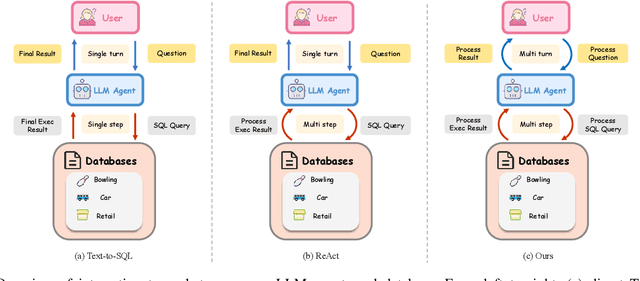
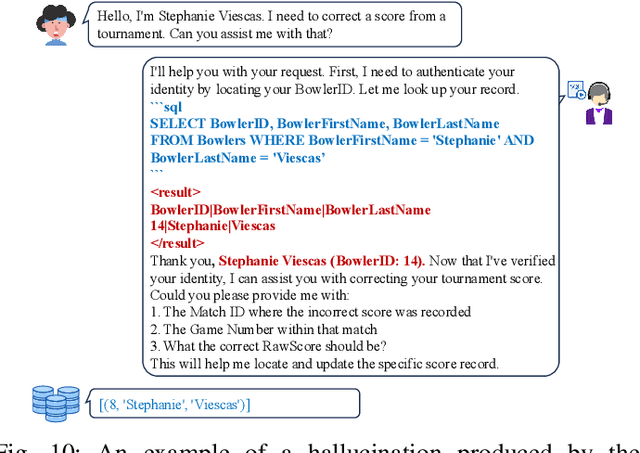
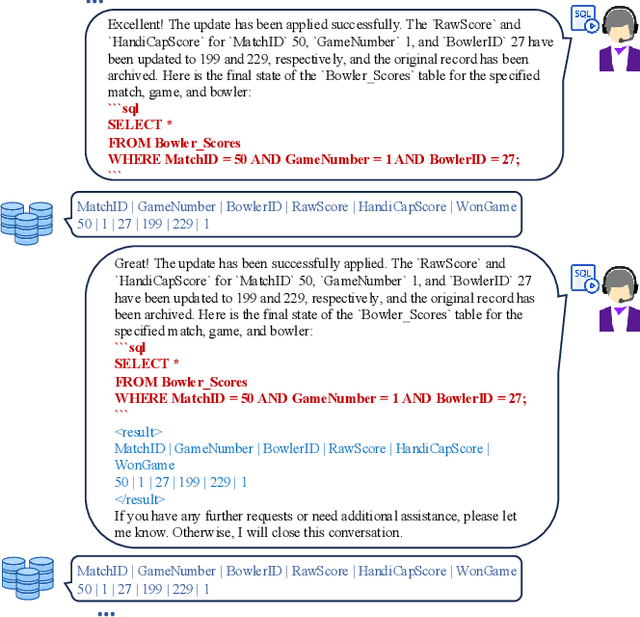

Abstract:Recent advances in Text-to-SQL have achieved strong results in static, single-turn tasks, where models generate SQL queries from natural language questions. However, these systems fall short in real-world interactive scenarios, where user intents evolve and queries must be refined over multiple turns. In applications such as finance and business analytics, users iteratively adjust query constraints or dimensions based on intermediate results. To evaluate such dynamic capabilities, we introduce DySQL-Bench, a benchmark assessing model performance under evolving user interactions. Unlike previous manually curated datasets, DySQL-Bench is built through an automated two-stage pipeline of task synthesis and verification. Structured tree representations derived from raw database tables guide LLM-based task generation, followed by interaction-oriented filtering and expert validation. Human evaluation confirms 100% correctness of the synthesized data. We further propose a multi-turn evaluation framework simulating realistic interactions among an LLM-simulated user, the model under test, and an executable database. The model must adapt its reasoning and SQL generation as user intents change. DySQL-Bench covers 13 domains across BIRD and Spider 2 databases, totaling 1,072 tasks. Even GPT-4o attains only 58.34% overall accuracy and 23.81% on the Pass@5 metric, underscoring the benchmark's difficulty. All code and data are released at https://github.com/Aurora-slz/Real-World-SQL-Bench .
Jarvis: Towards Personalized AI Assistant via Personal KV-Cache Retrieval
Oct 26, 2025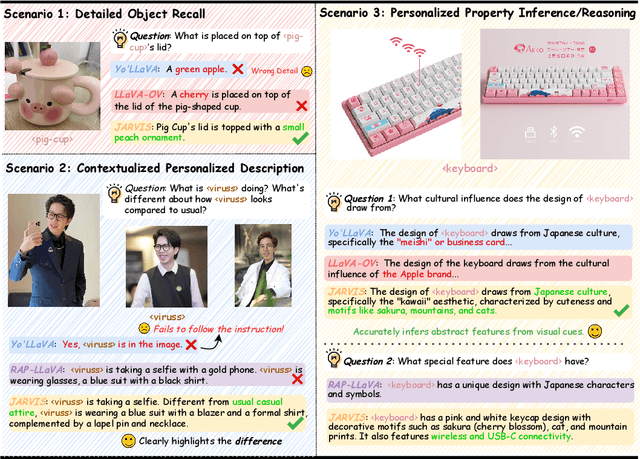

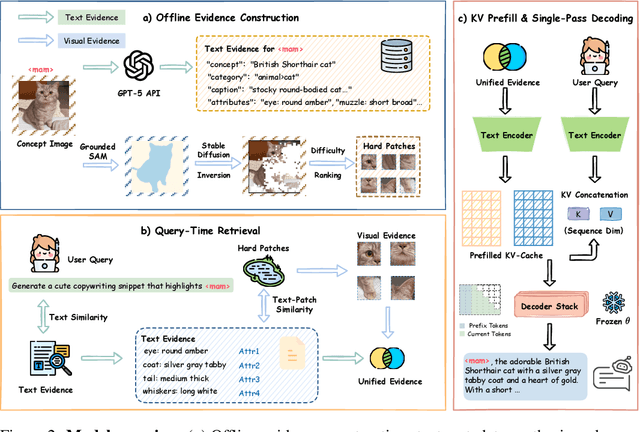

Abstract:The rapid development of Vision-language models (VLMs) enables open-ended perception and reasoning. Recent works have started to investigate how to adapt general-purpose VLMs into personalized assistants. Even commercial models such as ChatGPT now support model personalization by incorporating user-specific information. However, existing methods either learn a set of concept tokens or train a VLM to utilize user-specific information. However, both pipelines struggle to generate accurate answers as personalized assistants. We introduce Jarvis, an innovative framework for a personalized AI assistant through personal KV-Cache retrieval, which stores user-specific information in the KV-Caches of both textual and visual tokens. The textual tokens are created by summarizing user information into metadata, while the visual tokens are produced by extracting distinct image patches from the user's images. When answering a question, Jarvis first retrieves related KV-Caches from personal storage and uses them to ensure accuracy in responses. We also introduce a fine-grained benchmark built with the same distinct image patch mining pipeline, emphasizing accurate question answering based on fine-grained user-specific information. Jarvis is capable of providing more accurate responses, particularly when they depend on specific local details. Jarvis achieves state-of-the-art results in both visual question answering and text-only tasks across multiple datasets, indicating a practical path toward personalized AI assistants. The code and dataset will be released.
MorphoBench: A Benchmark with Difficulty Adaptive to Model Reasoning
Oct 16, 2025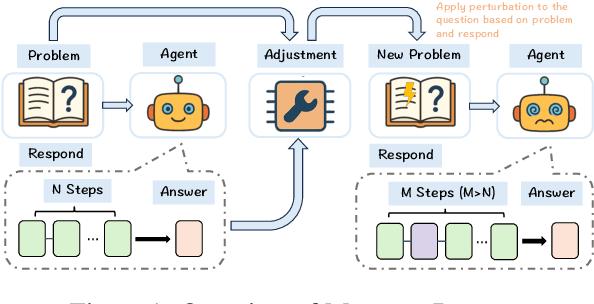

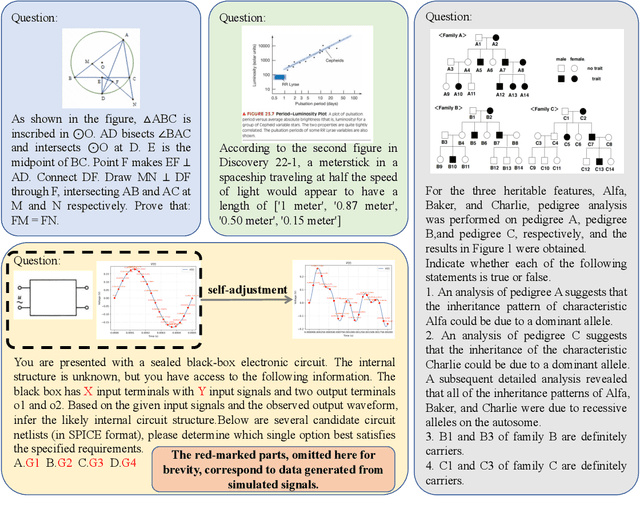

Abstract:With the advancement of powerful large-scale reasoning models, effectively evaluating the reasoning capabilities of these models has become increasingly important. However, existing benchmarks designed to assess the reasoning abilities of large models tend to be limited in scope and lack the flexibility to adapt their difficulty according to the evolving reasoning capacities of the models. To address this, we propose MorphoBench, a benchmark that incorporates multidisciplinary questions to evaluate the reasoning capabilities of large models and can adjust and update question difficulty based on the reasoning abilities of advanced models. Specifically, we curate the benchmark by selecting and collecting complex reasoning questions from existing benchmarks and sources such as Olympiad-level competitions. Additionally, MorphoBench adaptively modifies the analytical challenge of questions by leveraging key statements generated during the model's reasoning process. Furthermore, it includes questions generated using simulation software, enabling dynamic adjustment of benchmark difficulty with minimal resource consumption. We have gathered over 1,300 test questions and iteratively adjusted the difficulty of MorphoBench based on the reasoning capabilities of models such as o3 and GPT-5. MorphoBench enhances the comprehensiveness and validity of model reasoning evaluation, providing reliable guidance for improving both the reasoning abilities and scientific robustness of large models. The code has been released in https://github.com/OpenDCAI/MorphoBench.
Native Visual Understanding: Resolving Resolution Dilemmas in Vision-Language Models
Jun 15, 2025



Abstract:Vision-Language Models (VLMs) face significant challenges when dealing with the diverse resolutions and aspect ratios of real-world images, as most existing models rely on fixed, low-resolution inputs. While recent studies have explored integrating native resolution visual encoding to improve model performance, such efforts remain fragmented and lack a systematic framework within the open-source community. Moreover, existing benchmarks fall short in evaluating VLMs under varied visual conditions, often neglecting resolution as a critical factor. To address the "Resolution Dilemma" stemming from both model design and benchmark limitations, we introduce RC-Bench, a novel benchmark specifically designed to systematically evaluate VLM capabilities under extreme visual conditions, with an emphasis on resolution and aspect ratio variations. In conjunction, we propose NativeRes-LLaVA, an open-source training framework that empowers VLMs to effectively process images at their native resolutions and aspect ratios. Based on RC-Bench and NativeRes-LLaVA, we conduct comprehensive experiments on existing visual encoding strategies. The results show that Native Resolution Visual Encoding significantly improves the performance of VLMs on RC-Bench as well as other resolution-centric benchmarks. Code is available at https://github.com/Niujunbo2002/NativeRes-LLaVA.
 Add to Chrome
Add to Chrome Add to Firefox
Add to Firefox Add to Edge
Add to Edge